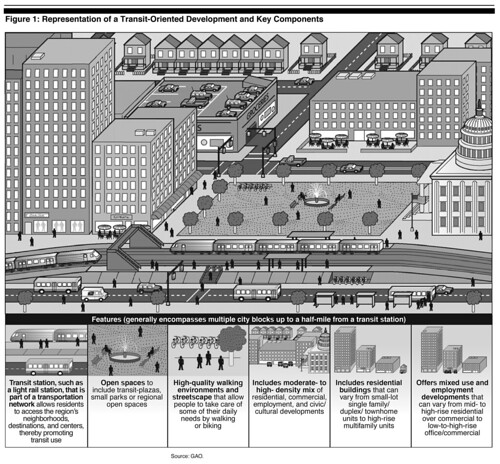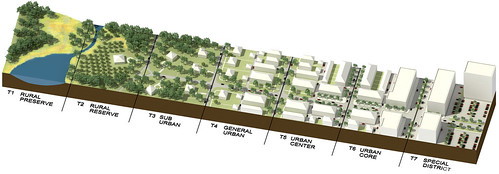
Rhode Island Row, apartment built to look like rowhouses, is having its grand opening tomorrow.
EYA, a regional homebuilder, specializes in new rowhouse projects on infill and subway station properties, and they built a number of buildings near the Silver Spring Metro station. While I think the company does good work, I often believe that their rowhouse "product" isn't the right one for locations on Metro sites, and within 0.25 to 0.5 miles of subway stations.
Now, to me, the idea of capturing the value of proximity to transit, what is called transit oriented development, especially right at Metro Stations, means that the buildings should be denser, and more traditionally like apartment buildings rather than rowhouses.
This makes sense, based on the increases in the value of the land that derives from transit proximity and access to the network, as well as it being in the city.
New Urban Transect rendition by Topografis PC, on Flickr.
Something like this, although this building, to be constructed next to the Wardman Park Hotel in Woodley Park, is much grander maybe than what would be typical at a Metro station _in the city_ makes more sense, and would better leverage the value of the land.

Rendering from the DC MUD article, "JBG's Woodley Park Residential Tower Reborn as 2700 Woodley."
But these types of "products"--rowhouses and small-scale apartments built to look like rowhouses--are much cheaper to build than taller apartment buildings--because beyond 5 stories, building and fire protection codes require concrete protection for safety reasons--and there are plenty of examples of so-called stick built projects going up in flames, including Santana Row in San Jose, California, and apartments being constructed for Virginia Commonwealth University in Richmond.
The one advantage of rental housing at Metro sites is that it isn't necessarily permanent, unlike owner-occupied housing, so if the building type, over time, isn't right for the site, it can be replaced.
But that is a longer process for sites not directly within the core of the city, where perception of value is much more of a longer term proposition and takes longer to realize.
Labels: housing, land use planning, real estate development, urban design/placemaking







0 Comments:
Post a Comment
<< Home